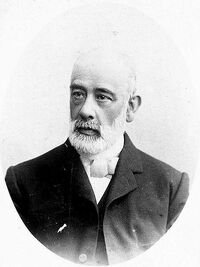
K.A. President Diego Cortez y Catalán.
The Great Northern War was a war fought between the United States of Mexico and the Russian Empire. The war began on 21 May 1898, and effectively ended on 5 September 1900 when Michael, the last Tsar of Russia, abdicated, although fighting continued until October 1901. The war resulted in the breakup of the Russian Empire, and the establishment of Mexican client states in Alaska and Siberia.
Causes of the War[]
The origins of the Great Northern War go back to 1894, when Diego Cortez y Catalán, the President of Kramer Associates, negotiated an agreement with the Russian government granting K.A. a concession in the Yukon region of Alaska to prospect for copper "and whatever other minerals might be found." In July 1896, a K.A. prospecting party led by Winston Carew struck a vein of gold.
News of the discovery soon reached the Russian government, and Tsar Nicholas II sent his personal congratulations to Cortez and Carew. By October 1897, however, the Russian government claimed that K.A.'s concession had covered copper only, and that all the gold recovered from the Yukon fields were Russian property.
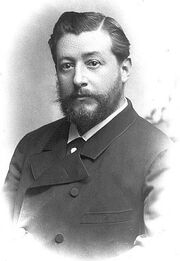
U.S.M. Chief of State Benito Hermión.
When Cortez received a telegram from Russian Foreign Minister Prince Pyotr Sviatopolk-Mirsky on 21 October informing him of this interpretation of the agreement, he ran shouting from his office in San Francisco, California. Cortez immediately telephoned Mexican Chief of State Benito Hermión and arranged for a meeting in Mexico City on 25 October. The two men met twice that day, and although no record exists of their discussions, Hermión evidently refused to confront the Russians over the matter.
Cortez than began plotting to provoke a war between Mexico and Russia, sending his private secretary Russell Smith to meet with Alberto Puente, the Governor of California, on 7 November to arrange matters. Four months later, on 27 February 1898, Puente notified Hermión of "repeated violations of the border by Russian Imperial forces." Hermión sent a team (presumably of Constabulary agents, although Sobel does not say so) to the area to investigate the situation. However, suspecting that Cortez might be behind Puente's message, Hermión telephoned him and informed him that "under no conditions will you involve Mexico in a squabble with the Russians. If you start trouble with the Russians, you will have to end it, and not I."
The investigative team reported its findings on 15 March, noting that violations of the border had in fact taken place, and that the Russian officer in charge of the border, Captain Boris Tschakev, had been "most uncooperative throughout." As a matter of form, Hermión sent a mild note of protest to St. Petersburg. When the Russian response was received, Henry Wilson, the chief Russian translator at the State Department, apparently mistranslated it to make it sound more belligerent. Sobel notes that Wilson was a former K.A. employee, and admits that it was "entirely possible he exaggerated the tone of the Mirsky telegram."
Over the next six weeks, a series of ten telegrams were exchanged between Mexico City and St. Petersburg, each presumably mistranslated by Wilson, and each harsher and more belligerent than the one before. On 4 May, Hermión ordered extensive summer maneuvers by the Mexican army, and ordered Admiral Ephraim Small to prepare the Mexican Pacific Fleet for a cruise to Hawaii. Prince Sviatopolk-Mirsky responded by ordering General Andrei Mishikov of the Alaska command to be on guard "against the possibility of sudden attack." There was a major incident on the Alaska-California border on 17 May, and four days later a Russian brigade entered California and began driving south for San Francisco. Diego Cortez had his war.
The Alaska Campaign[]
The California Guard, under the nominal command of Governor Puente, fell back before the Russian force for ten days, then made a stand twenty miles north of San Francisco while Puente sent a message to Hermión requesting "immediate and large-scale help." Admiral Small entered San Francisco Bay on 30 May, and landed a force of 20,000 marines, which joined the Californians and defeated the Russian brigade. The combined force then followed the fleeing Russian troops north, entering Alaska on 11 June. The marines and Californians were met there by an additional 40,000 Mexican soldiers under the command of General Richard Stockton.
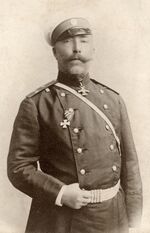
General Mikhail Kornilov.
Admiral Small's fleet landed an additional force of marines at the Russian port of Nikolaevsk on 5 July, which then advanced south towards the retreating Russians. The Russians were trapped, and General Mikhail Kornilov surrendered to General Stockton in August. Stockton sent troops to the Yukon gold fields along with engineering teams from K.A., in order to prepare for the establishment of mining camps the following spring. Meanwhile, Small landed more marines along the Alaskan coast, along with elements of the Caribbean Fleet under the command of Captain Nicholas Seger. By early October 1898, all of Alaska except the Aleutian Islands was under Mexican control.
Without consulting Hermión, Cortez contacted government officials in Japan, requesting their assistance in negotiating a peace treaty between Mexico and Russia. The Japanese Premier, Count Masayoshi Matsukata, was eager to do so, fearing the growing Mexican influence in the Pacific that the conquest of Alaska and the earlier annexation of Hawaii demonstrated. On 5 January 1899 the Japanese ambassador to Mexico, Ono Yamashita, met with Secretary of State Felicio Montoya and asked whether Hermión was prepared to set down his terms for peace. At the same time, ambassador to St. Petersburg Baron Keigo Kiyoura spoke with Prince Sviatopolk-Mirsky about possible Japanese mediation. Sviatopolk-Mirsky suggested Tokyo as a suitable site for negotiations, but Montoya, under orders from Hermión, told Yamashita that Mexico would discuss peace only if the Russians admitted that they had violated Californian territory, would cede Alaska to Mexico, and would pay an indemnity of $2.5 million. The Russians refused Hermión's terms, and the war continued.
The Siberia Campaign[]
On 28 May 1899 a Mexican naval force began the occupation of the Aleutian Islands. While the occupation was still going on, the Pacific Fleet left Hawaii and began steaming west to Siberia. The Pacific Fleet landed a force of marines at Petropavlovsk, Kamchatka on 28 June, followed by landings at Okhotsk on 15 July and at Nikolaevsk-on-Amur on 26 July. The Russians attempted to halt the Nikolaevsk landings by engaging the Pacific Fleet at the Battle of the Okhotsk Sea on 23 July. The battle was a complete Mexican victory, with the Russians losing two battleships and fourteen other ships sunk, and the loss of 20,000 men. The Mexicans lost only nine dead and fourteen wounded when a boiler on the battleship Andrew Jackson exploded. By 10 August the three Mexican beachheads were joined, and Mexican troops had marched inland to secure all Siberian territory within 200 miles of the Pacific coast.
By early October 1899 all the major population centers up to the Kolyma River were in Mexican hands, while in the south the Mexican marines ruled the region as far inland as Kharbarevsk. The Mexicans freed 80,000 Russian political prisoners being held in prison camps in Kamchatka, and some 7,000 organized the Free Russian Brigade, which fought alongside the Mexicans and rendered invaluable assistance during the campaign. Admiral Small was named Administrator of Siberia, establishing his headquarters at Udsk. In November, Small received permission from Hermión to organize the freed political prisoners into a "Provisional Free Russian Government", which was recognized by the U.S.M. as the legitimate authority in Siberia under Premier George Tsukansky on 23 November 1899.
The Russian Revolution[]
News of the loss of Alaska and Siberia to the Mexicans brought about an economic and financial crisis in Russia. This led to an uprising in St. Petersburg on 2 February 1900 which spread from there to the rest of European Russia. The most important revolutionary leaders were Count Serge Witte, Pavel Miliukov, and General Vladimir Malenkov.
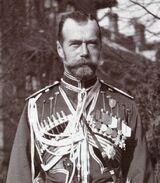
Tsar Nicholas II.
In the Ukraine, General Malko Hrishchiev formed his own provisional government, with power being exercised behind the scenes by a cabal of young officers led by Major Simon Petlura. This was followed by Poland and the Baltic States breaking away from the Russian Empire. By early July, the new national armies and the revolutionaries had united to defeat the forces loyal to Tsar Nicholas II. Nicholas was obliged to abdicate on 17 July in favor of his brother Michael II, and he and his family fled to Great Britain. Two months later, Tsar Michael gave up hope of remaining in power, and on 5 September he and the remainder of the Russian royal family fled to Sweden.
The ease with which the Mexican military had defeated the Russians and conquered Alaska and Siberia caused Hermión to begin to dream of greater things. By 1901 the U.S.M. with its dependant states was the second-largest nation in the world. Alaska and Siberia combined were three times the size the U.S.M. had been in 1881. Hermión revealed the scope of his new ambitions on 2 April 1901, when he declared the transformation of the U.S.M. into the Mexican Empire, and had himself crowned Emperor Benito I. Privately, the new emperor predicted that his dynasty would one day "rule not only continents, but the great globe itself."
The Cortez Coup[]
President Cortez had been satisfied with the occupation of Alaska, and strongly opposed the invasion of Siberia. In November 1899 Cortez met with Hermión in San Francisco and warned him that "Siberia has nothing we need. Alaska was another matter entirely. Unless we can extract ourselves with honor and dignity, we will either be expelled by the European powers or sink into the icy morass of a useless land."
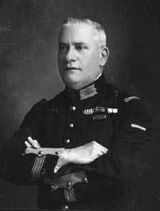
Kramer Guard Commandant Martin Cole.
Cortez was dismayed by the outbreak of the Russian Revolution and the signing of the Yamagata-Macmillan Treaty by Japan and Great Britain in 1901. He decided that it would be necessary to depose Hermión, and he began contacting various opponents of the government. At a meeting on 1 August 1901, Cortez and fourteen opposition leaders discussed Hermión's removal. After the others had spoken, Cortez revealed his plan to send 2,000 Kramer Guards to surround the newly-rechristened Imperial Palace, cut it off from the outside, and maneuver Hermión into fleeing into exile.
On the night of 15 October, Cortez' men, led by Guard Commandant Martin Cole, carried out the plan. Hermión fled the following morning, closely followed by over three hundred K.A. agents, while Cole proclaimed a provisional government. Under orders from Cortez, Cole had Admiral Small end offensive operations in Siberia and prepare to hand over control of Siberia to the Free Russian Government, by now under the rule of Tschakev. The last Mexican marines withdrew from Siberia in 1903, leaving Tschakev in charge politically while Cortez controlled the economy.
Sources[]
Sobel's sources for the Great Northern War are Michael Suzanov's Siberia Under Mexican Domination: the First Year (London, 1910); Feodor Kluchansky's Russia in Exile (London, 1911); Andrew Stirling's The Secret History of the Great Northern War (London, 1923); Felix Noland's A Military History of the Great Northern War (London, 1925); William Reilly's "Henry Wilson's Role in Initiating the Great Northern War" from The Journal of Russian Studies, XXVII (June, 1934); Isadore Klineburg's Count Matsukata and the Emergence of Japan (Melbourne, 1960); Carl Needham's The Great Northern War (New York, 1963); C. Hadley McCoy's The Beginning of Modern Times (London, 1965); Knute Neuberger's The Background of the Great Northern War (London, 1965); Zoë Montgomery's The Russian Revolution (New York, 1967); Miguel Señada's Cortez and Hermión: Bitter Friendship (Mexico City, 1968); and Stanley Tulin's The Kramer Associates: The Cortez Years (London, 1970).
This was the Featured Article for the week of 24 November 2013.
